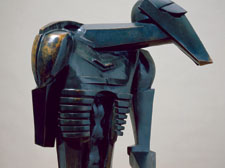|
|
 |
| |

Epstein: Torso in Metal from the Rock Drill, 1913-14, Bronze, Tate London |
In at the birth of modern sculpture
WILD THING : EPSTEIN, GAUDIER-BRZESKA, GILL
Royal Academy
THE radical change that transformed British sculpture in the decade before the First World War is the focus for a major Royal Academy of Arts exhibition beginning next month and running until January.
Three outstanding sculptors, Jacob Epstein (1880-1959), Henri Gaudier-Brzeska (1891-1915) and Eric Gill (1882-1940), are to feature.
It will be the first time their works – more than 90 in all – have been shown together in this context, many having not been exhibited in London before.
There will be rooms dedicated to the artists examining the key achievements of each, with sculptures, drawings and pastels. The exhibition will bring together spectacular works, including Epstein’s Rock Drill, Gaudier’s Birds Erect, and Gill’s controversial carving of the sexual act, Ecstasy, so called after being retitled from a more explicit version beginning with F.
The show will draw on the major themes that impressed the three, from sexual obsessions, through fertility, the machine age and war.
Their origins could hardly have been more diverse. Epstein was of Polish Jewish parents from New York, who settled in London in 1905 and became a British citizen two years later; Frenchman Gaudier, who settled in the capital from 1911, the son of an Orleans carpenter; and Gill, the son of a Brighton clergyman, who earnt his living first as a letter cutter and was also renowned for his typography and engraving.
But the RA’s exhibition aims to examine how they “…brought about the birth of modern British sculpture”.
And the idea of wildness is a central aspect, the Wild Thing title coming from Ezra Pound’s description of Gaudier as like “…some soft-moving, bright-eyed wild thing”.
Gill, who befriended Epstein, thought him determined “to rescue sculpture from the grave”. Gaudier visited Epstein’s studio and was impressed by his powerful Tomb of Oscar Wilde on display there.
An outstanding sculptor and draughtsman, Gaudier was to die on the Western Front aged just 23 in 1915.
|

|
 |
| |
|
 |
|

